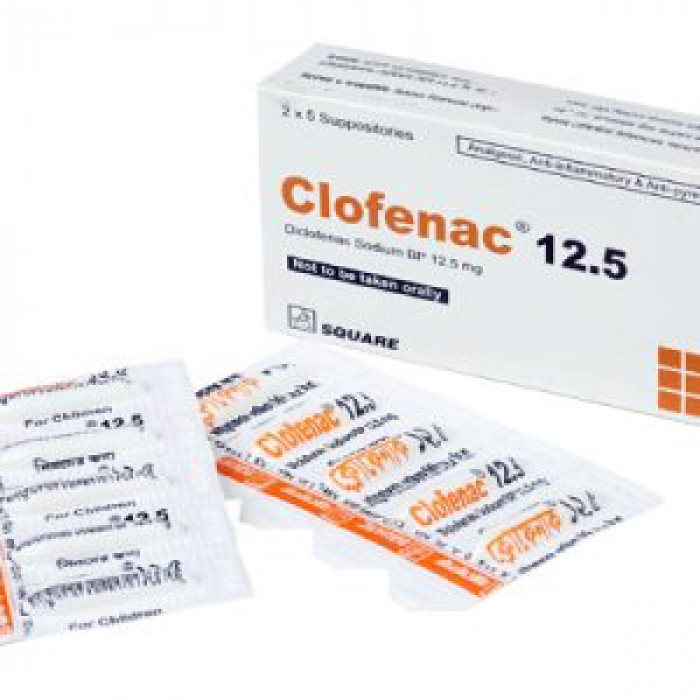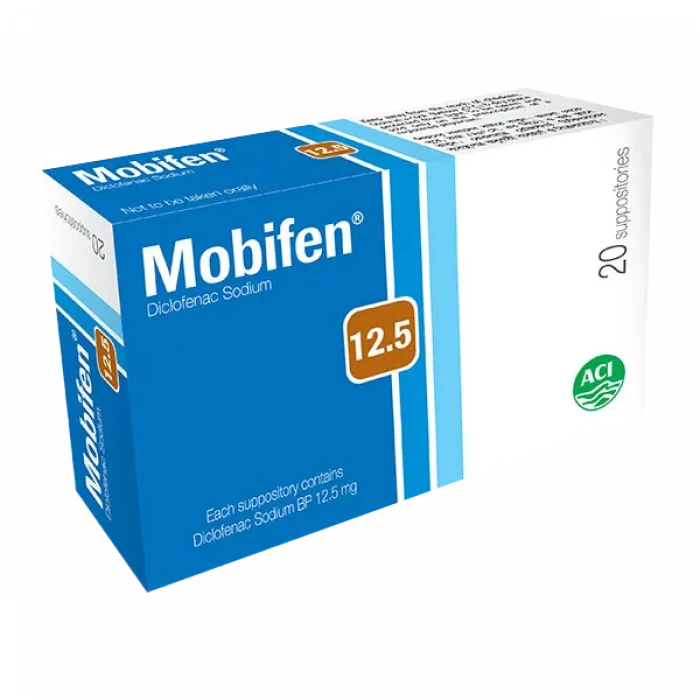
✔ 100% Authentic Product
👁️ Currently Viewing 4106
Clofenac 12.5mg Suppository 5pcs
Generic Name: Diclofenac Sodium 12.5mg
Manufacturer/Distributor: Square Pharmaceuticals Ltd.
Discount
Price: ৳ 11
MRP:
৳
12
5%
Off

100% Genuine Products, Guaranteed

Safe & Secure Payments, Always

Fast, Secure & Efficient Delivery

Proper Packaging
 Cash on Delivery - All over Bangladesh
Cash on Delivery - All over Bangladesh Regular Delivery - 12-24 Hours, Dhaka City* Charge Tk.39-59
Regular Delivery - 12-24 Hours, Dhaka City* Charge Tk.39-59 Regular Delivery - 24-48 Hours, Other Cities* Charge Tk.99-110
Regular Delivery - 24-48 Hours, Other Cities* Charge Tk.99-110
 ফ্রি ডেলিভারিঃ - ৯৯৯ টাকা+ অর্ডারে, ঢাকা
শহরে
ফ্রি ডেলিভারিঃ - ৯৯৯ টাকা+ অর্ডারে, ঢাকা
শহরে ফ্রি ডেলিভারিঃ - ২৯৯৯ টাকা+ অর্ডারে, ঢাকার
বাহিরে
ফ্রি ডেলিভারিঃ - ২৯৯৯ টাকা+ অর্ডারে, ঢাকার
বাহিরে
100% Genuine Products, Guaranteed
Safe & Secure Payments, Always
Fast, Secure & Efficient Delivery
Proper Packaging
 Cash on Delivery - All over Bangladesh
Cash on Delivery - All over Bangladesh Regular Delivery - 12-24 Hours, Dhaka City* Charge Tk.39-59
Regular Delivery - 12-24 Hours, Dhaka City* Charge Tk.39-59 Regular Delivery - 24-48 Hours, Other Cities* Charge Tk.99-110
Regular Delivery - 24-48 Hours, Other Cities* Charge Tk.99-110 ফ্রি ডেলিভারিঃ - ৯৯৯ টাকা+ অর্ডারে, ঢাকা
শহরে
ফ্রি ডেলিভারিঃ - ৯৯৯ টাকা+ অর্ডারে, ঢাকা
শহরে ফ্রি ডেলিভারিঃ - ২৯৯৯ টাকা+ অর্ডারে, ঢাকার
বাহিরে
ফ্রি ডেলিভারিঃ - ২৯৯৯ টাকা+ অর্ডারে, ঢাকার
বাহিরে
✅ Description:
Indications of Clofenac 12.5
- Rheumatology includes inflammatory and degenerative rheumatism, polyarthritis, ankylosing spondylarthritis, osteoarthritis, spondylarthritis, acute gout, and peri-articular rheumatic diseases.
- Sprains, bruises, dislocations, fractures, soft-tissue injuries, and surgical procedures are all examples of surgery and traumatology.
- Primary dysmenorrhoea, episiotomy, adnexitis, endometritis, parametritis, salpingitis, and mastitis are all conditions seen in obstetrics and gynecology.
- Pre-operative medication for the prevention of pain, inflammation, and edema in otorhinolaryngology.
- Post-operative and post-traumatic discomfort, inflammation, and swelling are common in dentistry.
- Other indications include pain relief and the treatment of inflammation and edema in patients who have had urogenital, renal, or biliary colic.
Pharmacology
Diclofenac Sodium is an anti-rheumatic, anti-inflammatory, analgesic, and antipyretic non-steroidal anti-inflammatory medication (NSAID). It also contains uricosuric properties. Diclofenac works by inhibiting prostaglandin production, which is a key factor in the development of inflammation, discomfort, and fever. When taken with or after a meal, diclofenac is swiftly and thoroughly absorbed from the gastrointestinal tract. After consumption, peak plasma concentrations are obtained in an average of 2 hours. It is 99.7% bound to plasma proteins at therapeutic dosages. Diclofenac is metabolized in the liver and goes through a first-pass process.
Dosage & Administration
Adults should take a 50 mg diclofenac suppository 2-3 times per day. The daily maximum dose is 150 mg.
Interaction of Clofenac 12.5
When combined with other drugs that can cause bleeding, this medication can increase the risk of bleeding. Antiplatelet medications like clopidogrel, as well as "blood thinners" like dabigatran/enoxaparin/warfarin, are examples.
Contraindications
Patients who are hypersensitive to any of the items' ingredients should avoid using it. Peptic ulcer, hypersensitivity to Diclofenac, as well as other non-steroid anti-inflammatory agents. Diclofenac is also contra-indicated in asthmatic patients who have had an attack of asthma, urticaria, or acute rhinitis triggered by acetylsalicylic acid or other drugs that inhibit prostaglandin synthetase. Under occlusive airtight dressings, this Gel should not be utilized.
Side-Effects of Clofenac 12.5
Diclofenac Sodium is well tolerated by most people. Mild, infrequent, and temporary side effects are common. Patients may have epigastric pain, eructation, nausea, and diarrhea, as well as dizziness or headache, during the commencement of treatment. In most cases, these side effects are minor. Edema in the legs and skin responses including rash and eczema have also been reported. Diclofenac Sodium Gel can produce skin irritation, reddening, and a rash on the affected area.
Pregnancy & Lactation
Diclofenac should only be used if absolutely necessary during pregnancy. The smallest dose that is effective should be utilized. These medications are not advised to be taken during the first trimester of pregnancy. Diclofenac Sodium Gel is not suggested during pregnancy due to a lack of clinical evidence. Although a trace amount of Diclofenac may be discovered in breast milk, no adverse effects on the newborn are expected.
Precautions
In rare cases, patients using Diclofenac may develop peptic ulcers or experience gastrointestinal bleeding. Patients in their advanced years should be closely monitored. Diclofenac Sodium Gel should not be applied to the eyes or mucous membranes, and the hands should be thoroughly cleansed after application. It should not be consumed by mouth.
Storage Conditions
Store in a cold, dry, and light-protected location. Keep it below 30°C. Keep out of children's reach.
⚠️Disclaimer:
At ePharma, we’re committed to providing accurate and accessible health information. However, all content is intended for informational purposes only and should not replace medical advice from a qualified physician. Please consult your healthcare provider for personalized guidance. We aim to support, not substitute, the doctor-patient relationship.








